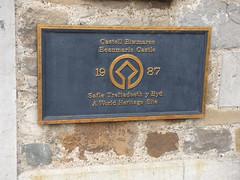Beaumaris Castle
Commemorated on 1 plaque
Castell Biwmares Beaumaris Castle 1987 Safle Treftadaeth y Byd A World Heritage Site
English translation: Beaumaris Castle 1987 A World Heritage Site
Ticket office - Beaumaris Castle, Beaumaris, United Kingdom where it built (1295-1330)


